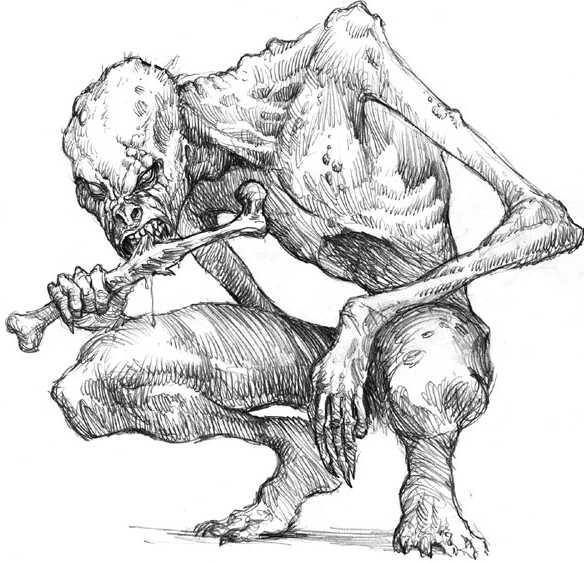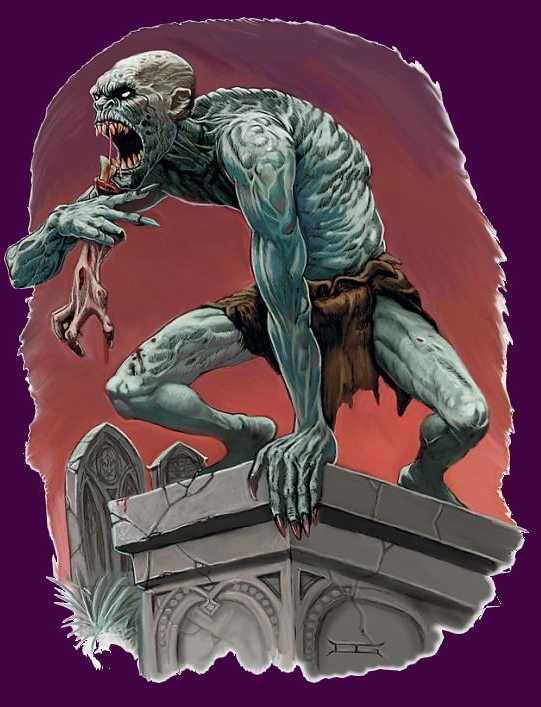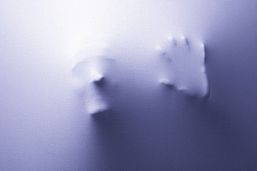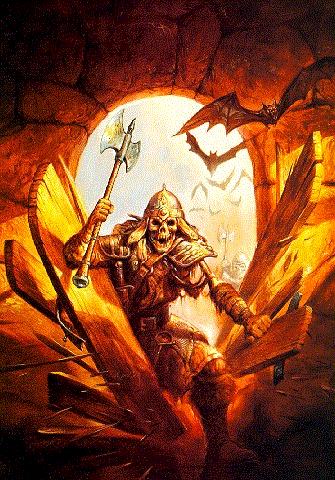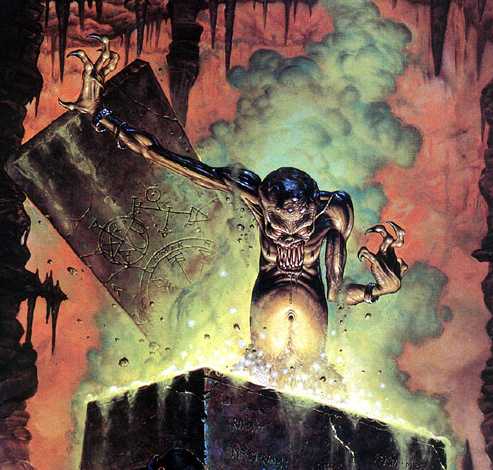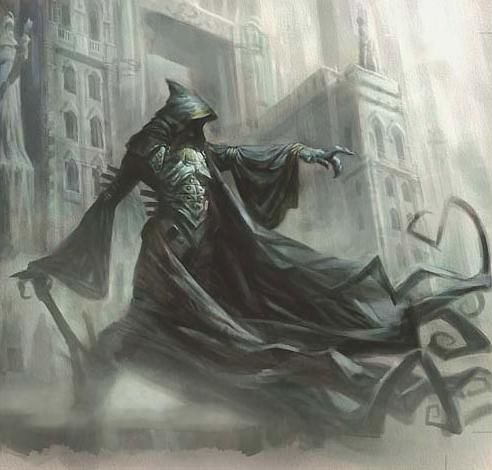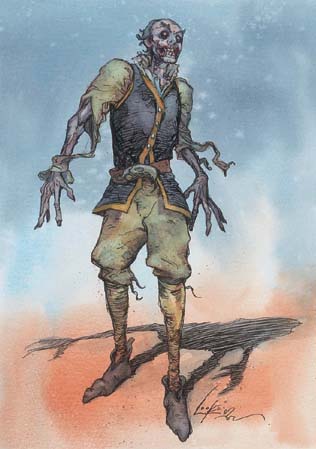
Like their counterparts the juju
zombie or zuvembie is a reanimated human corpse, but they differ from the
common zombie in many ways. The juju zombie is created through means of
ritual evil voodoo. Juju zombies are among the lower forms of the undead,
made to serve their Bokor (evil voodoo witchdoctor) in some way; providing
effective slave labour, protection, or resolving vendettas. The juju zombie
is the scourge of the Houngan (good voodoo priest) who must defend their
lands against the threat of those that use voodoo magic for dark purposes.
Zombification through evil voodoo is really a form of possession. Juju
zombies are animated by the Loa (voodoo spirit-gods) that inhabit the juju
zombie's form and controlled by the bokor who summoned them. More powerful
than the common zombie, the juju zombie is slightly more intelligent as
well, able to perceive and understand simple commands from their masters.
Another distinction from the common zombie is that the bite of a juju zombie
will not cause its victim to metamorphose into the Living Dead.
The methods of creating and
controlling juju zombies vary among Bokors. Some Bokors use blood and hair
from their victims in conjunction with voodoo dolls to create and control
their zuvembies. Others methods of zombification involve a specially
prepared concoction of mystical herbs, in addition to human and animal
parts. The ingredients are all ground into a fine dust or even brewed into a
potion. The dust may be blown into the unaware victim's face. Ingestion,
injection, or even a blow dart may be used to administer the potion variety.
When these substances come into contact with the victim's skin, bloodstream
or mucous membranes, the victim is rendered immobile within minutes, as they
succumb to a comatose-like state resembling death. The active ingredient
that causes this "death-in-life" affect is known as tetrodotoxin, although
little is known about this drug. After the victim is presumed dead, they are
commonly buried alive. Most victims are driven insane by this ordeal, making
them even more vulnerable to the Bokor's spells. The Bokor then performs an
ancient voodoo rite; taking possession or "trapping" the victim's soul, and
replacing it with the Loa that he or she controls. The victim's "trapped"
soul is usually placed within a small clay jar or some other unremarkable
container. The container is wrapped in a fragment of the victim's clothing,
a piece of jewellery, or some other personal possession owned by the victim
in life, and then hidden in a place of secrecy known only to the Bokor.
Another form of zombification includes the invocation of the serpent-god
Damballah, the most powerful of the Loa. Through this obscure ritual, a dead
body may be resurrected and controlled through the use of two matching
amulets. A juju zombie wearing an amulet around its neck can be verbally
commanded by anyone in possession of its counterpart.
There have been some rare occasions
of juju zombies temporarily regaining part of their mental faculties. For
reasons beyond explanation, their mortal persona is able to assume partial
control over their bodily actions. This rare occurrence has only been
observed when a juju zombie encounters situations that have heavy emotional
connections to their mortal lives. Now matter how strong their spirit was in
mortal life however, juju zombies are unable to resist the call of their
masters for long.
Type: Undead Corpse
Setting: In Haiti, the
Caribbean, and uninhabited regions throughout the eastern coasts of Africa.
They are usually encountered in graveyards, cemeteries, underground tunnels
and catacombs, caverns, abandoned mines, swamps, marshes and bayous,
tropical jungle climes, small or remote islands, and occasionally high
desert areas.
Era: Any
Physical Traits: Human in
appearance; varying with signs of desiccation, decay, and emaciation. They
have blank, expressionless faces with white eyes. Many are incapable of
speech but most are able to make moaning and guttural sounds. They are
normally encountered wearing whatever clothing they wore in their human life
prior to reanimation. They may also be seen wearing slave rags or garments
given to them by their Bokor.
Height: Varies according to
original height
Weight: Varies according to
original weight
Mobility: Legs
Sensory Organs: Mystical
Communication: None
Reproduction: None
INT:
D6, WIS: D6, STR: 3D6 x3, DEX: 2D6, CON: 4D6,
CHA: D6, MR: D6, HPs: 6D6
AC: 6, Thac0:
15
Abilities:
1) Juju zombies are impervious to pain and require no air to breathe. They
are thus immune to drugs, poisons, gases, suffocation, and drowning. Zombies
never sleep, and they are incapable of fatigue. Juju zombies do not possess
night vision, a characteristic usually common to most undead monsters.
2) Although they are not
invulnerable, the lifeless, reanimated body of a juju zombie possesses a
supernatural healing ability, enabling them to regenerate missing or injured
tissue, and mend broken bones. Juju zombies can recover from small burns,
lacerations, and gunshot wounds within a matter of hours. Juju zombies
cannot regenerate missing limbs, however. Dismembering the legs will render
the juju zombie immobile, but the creature will still continue to subsist.
Likewise, decapitation will incapacitate the body, but the head will still
live. They are also immune to certain other mortal vulnerabilities,
including suffocation, drowning, extremes of temperature and pressure, high
voltage electricity, poisonous gas and drugs.
3) Juju zombies possess superhuman
strength three times greater than what they possessed while alive.
4) Unlike their counterpart, the
common zombie, juju zombies do not express any fear or hesitation in their
actions even when confronted by certain peril (e.g. fire).
Juju zombies are highly susceptible
to fire. Burning zuvembies is the most effective way of destroying them. The
flesh of these creatures can be burned so totally that they cannot recover.
Juju zombies are vulnerable to the voodoo which gives them animation. The
proper incantation and treatment of a voodoo doll can cause supernatural,
debilitating pain to a zuvembie. A juju zombie can also be put to final rest
through the appropriate voodoo ceremony, which forces the loa from
its body. There are certain mystical totems and fetishes that offer
protection from zuvembies. These items can be worn about the neck or adorned
in some other fashion. It should be noted that while these objects will
offer protection against physical contact from zuvembies, these devices may
not offer the same defence against their masters.
Feeding Habits: Fresh
mammalian flesh.
Lifespan: Variable, depending
on the state of decomposition upon reanimation and environmental factors
which may affect the continuing process of decay. Because of the
supernatural enhancements they possess over the common zombie, most juju
zombies can exist for 20 to 30 years before eventual putrefaction would
threaten their mobility.
